Effect of Addition of Cross-Linked Starch on the Properties of Degraded PBAT Poly(butylene adipate-co-terephthalate) Films
Abstract
1. Introduction
2. Materials and Methods
2.1. Materials
Starch Chemical Modification
2.2. Film Elaboration
2.3. Film Characterization
2.3.1. Morphological Characterization
2.3.2. Moisture Content (MC) and Contact Angle (CA)
2.3.3. Fourier Transform Infrared Spectroscopy (FTIR)
2.3.4. Thickness and Mechanical Properties
2.3.5. Thermogravimetric Analysis (TGA)
2.4. Data Processing and Statistical Analysis
3. Results and Discussion
3.1. Morphological Characterization
3.2. Contact Angle (CA)
3.3. Fourier Transform Infrared Spectroscopy (FTIR)
3.4. Thickness and Mechanical Properties of Film Blends
3.5. Thermogravimetric Analyses (TGAs)
4. Conclusions
Author Contributions
Funding
Institutional Review Board Statement
Data Availability Statement
Acknowledgments
Conflicts of Interest
References
- Bardi, M.A.; Munhoz, M.M.; Auras, R.A.; Machado, L.D. Assessment of UV exposure and aerobic biodegradation of ploy(butylene adipate-co-terephthalate)/starch blend films coated with radiation-curable print inks containing degradation-promoting additives. Ind. Crops Prod. 2014, 60, 326–334. [Google Scholar] [CrossRef]
- Garcia, P.S.; Grossmann, M.V.E.; Shirai, M.A.; Lazaretti, M.M.; Yamashita, F.; Muller, C.M.O.; Mali, S. Improving action of citric acid as compatibilizer in starch/polyester blown films. Ind. Crops Prod. 2014, 52, 305–312. [Google Scholar] [CrossRef]
- López, J.; Mutjé, P.; Carvalho, A.; Curvelo, A.; Gironès, J. Newspaper fiber-reinforced thermoplastic starch biocomposites obtained by melt processing: Evaluation of the mechanical, thermal and water sorption properties. Ind. Crops Prod. 2013, 44, 300–305. [Google Scholar] [CrossRef]
- Cao, X.; Chang, P.R.; Huneault, M.A. Preparation and properties of plasticized starch modified with poly(ε-caprolactone) based waterborne polyurethane. Carbohydr. Polym. 2008, 71, 119–125. [Google Scholar] [CrossRef]
- Corradini, E.; de Morais, L.C.; Rosa, M.d.F.; Mazzetto, S.E.; Mattoso, L.H.C.; Agnelli, J.A.M. A preliminary study for the use of natural fibers as reinforcement in starch-gluten-glycerol matrix. Macromol. Symp. 2007, 1, 558–564. [Google Scholar] [CrossRef]
- Rosa, M.F.; Chiou, B.S.; Medeiros, E.S.; Wood, D.F.; Mattoso, L.H.; Orts, W.J.; Imam, S.H. Biodegradable composites based on starch/EVOH/glycerol blends and coconut fibers. J. Appl. Polym. Sci. 2008, 111, 612–618. [Google Scholar] [CrossRef]
- Wang, S.; Li, C.; Copeland, L.; Niu, Q.; Wang, S. Starch retrogradation: A comprehensive review. Compr. Rev. Food Sci. Food Saf. 2015, 14, 568–585. [Google Scholar] [CrossRef]
- Satyanarayana, K.G.; Arizaga, G.G.; Wypyc, F.H. Biodegradable composites based on lignocellulosic fibers—An overview. Prog. Polym. Sci. 2009, 34, 982–1021. [Google Scholar] [CrossRef]
- Babaee, M.; Jonoobi, M.; Hamzeh, Y.; AshorI, A. Biodegradability and mechanical properties of reinforced starch nanocomposites using cellulose nanofibers. Carbohydr. Polym. 2015, 132, 1–8. [Google Scholar] [CrossRef]
- Cerruti, P.; Santagata, G.; D’Ayala, G.G.; Ambrogi, V.; Carfagna, C.; Malinconico, M.; Persico, P. Effect of a natural polyphenolic extract on the properties of a biodegradable starch-based Polymer. Polym. Degrad. Stab. 2011, 96, 839–846. [Google Scholar] [CrossRef]
- Wei, D.; Wang, H.; Xiao, H.; Zheng, A.; Yang, Y. Morphology and mechanical properties of ploy(butylene adipate-co-terephthalate)/potato starch blends in the presence of synthesized reactive compatibilizer or modified ploy(butylene adipate-co-terephthalate). Carbohydr. Polym. 2015, 123, 275–282. [Google Scholar] [CrossRef]
- Seligra, P.G.; Moura, L.E.; Famá, L.; Druzian, J.I.; Goyanes, S. Influence of incorporation of starch nanoparticles in PBAT/TPS composite films. Polym. Int. 2016, 65, 938–945. [Google Scholar] [CrossRef]
- Costa, K.D.C.; de Souza, C.O.; da Silva, J.B.A.; Druzian, J.I. Hydrolysis of part of cassava starch into nanocrystals leads to increased reinforcement of nanocomposite films. J. Appl. Polym. Sci. 2017, 134, 45311. [Google Scholar] [CrossRef]
- Olivato, J.B.; Marini, J.; Pollet, E.; Yamashita, F.; Grossmann, M.V.E.; Avérous, L. Elaboration, morphology and properties of starch/polyester nano-biocomposites based on sepiolite clay. Carbohydr. Polym. 2015, 118, 250–256. [Google Scholar] [CrossRef] [PubMed]
- Ramadan, M.F.; Sitohy, M.Z. Phosphorylated Starches: Preparation, Properties, Functionality, and Techno-Applications. Starch-Stärke 2020, 72, 1900302. [Google Scholar] [CrossRef]
- Lemos, P.V.F.; Barbosa, L.S.; Ramos, I.G.; Coelho, R.E.; Druzian, J.I. Characterization of amylose and amylopectin fractions separated from potato, banana, corn, and cassava starches. Int. Biol. Macromol. 2019, 132, 32–42. [Google Scholar] [CrossRef]
- Merino, D.; Mansilla, A.Y.; Gutiérrez, T.J.; Casalongué, C.A.; Alvarez, V.A. Chitosan coated-phosphorylated starch films: Water interaction, transparency and antibacterial properties. React. Funct. Polym. 2018, 131, 445–453. [Google Scholar] [CrossRef]
- Brandelero, R.P.H.; Grossman, M.V.E.; Yamashita, F. Effect of the method of production of the blends on mechanical and structural properties of biodegradable starch films produced by blown film extrusion. Carbohydr. Polym. 2011, 86, 1344–1350. [Google Scholar] [CrossRef]
- Silva, N.M.C.; Correia, P.R.C.; Druzian, J.I.; Fakhouri, F.M.; Fialho, R.L.L.; Albuquerque, E.C. PBAT/TPS composite films reinforced with starch nanoparticles produced by ultrasound. Int. J. Polym. Sci. 2017, 2017, 4308261. [Google Scholar] [CrossRef]
- Nayak, S.K. Biodegradable PBAT/starch nanocomposites. Polym. Plast. Technol. Eng. 2010, 49, 1406–1418. [Google Scholar] [CrossRef]
- Wang, W.; Zhang, G.; Zhang, W.; Guo, W.; Wang, J. Processing and thermal behaviors of ploy(butylene succinate) blends with highly-filled starch and glycerol. J. Polym. Environ. 2012, 21, 46–53. [Google Scholar] [CrossRef]
- Li, J.; Luo, X.; Lin, X.; Zhou, Y. Comparative study on the blends of PBS/thermoplastic starch prepared from waxy and normal corn starches. Starch-Stärke 2013, 65, 831–839. [Google Scholar] [CrossRef]
- Averous, L.; Moro, L.; Dole, P.; Fringant, C. Blends of thermoplastic starch and polyesteramide: Processing and properties. J. Appl. Polym. Sci. 2000, 76, 1117–1128. [Google Scholar] [CrossRef]
- Li, G.; Favis, B.D. Morphology development and interfacial interactions in polycaprolactone/thermoplastic-starch blends. Macrom. Chem. Phys. Suppl. 2010, 211, 321–333. [Google Scholar] [CrossRef]
- Matzinos, P.; Tserki, V.; Kontoyiannis, A.; Panayiotou, C. Processing and characterization of starch/polycaprolactone products. Polym. Degrad. Stab. 2002, 77, 17–24. [Google Scholar] [CrossRef]
- Mina, H.J.; Valadez, G.A.; Toledano, T.T. Physico-chemical studied of thermoplastic starch (TPS) and polycaprolactone (PCL). Biotecnol. Sect. Agropecu. Agroind. 2013, 11, 31–40. Available online: http://www.scielo.org.co/scielo.php?script=sci_arttext&pid=S1692- (accessed on 18 July 2023).
- Arroyo, O.H.; Huneault, M.A.; Favis, B.D.; Bureau, M.N. Processing and properties of PLA/thermoplastic starch/montmorillonite nanocomposites. Polym. Compos. 2010, 31, 114–127. [Google Scholar] [CrossRef]
- Müller, P.; Imre, B.; Bere, J.; Móczó, J.; Pukánszky, B. Physical ageing and molecular mobility in PLA blends and composites. J. Anal Calorim. 2015, 122, 1423–1433. [Google Scholar] [CrossRef]
- Averous, L.; Fringant, C. Association between plasticized starch and polyesters: Processing and performances of injected biodegradable systems. Polym. Eng. Sci. 2004, 41, 727–734. [Google Scholar] [CrossRef]
- Averous, L.; Moro, L.; Dole, P.; Fringant, C. Properties of thermoplastic starch blends: Starch-polycaprolactone. Polymer 2000, 41, 4157–4167. [Google Scholar] [CrossRef]
- Lucas, N.; Bienaime, C.; Belloy, C.; Queneudec, M.; Silvestre, M.; Saucedo, J.E.N. Polymer biodegradation: Mechanisms and estimation techniques-A review. Chemosphere 2008, 73, 429–442. [Google Scholar] [CrossRef]
- Guocheng, H. An aging study of PLA-PBAT blends in commercial beverages. Journal of physics: Conference Series 2023, 2539, 012012. [Google Scholar] [CrossRef]
- Lemos, P.V.F.; Opretzka, L.C.F.; Almeida, L.S.; Cardoso, L.G.; Silva, J.B.S.; Souza, C.O.; Villarreal, C.F.; Druzian, J.I. Preparation and characterization of C-phycocyanin coated with STMP/ STPP cross-linked starches from different botanical sources. Int. J. Biol. Macromol. 2020, 159, 739–750. [Google Scholar] [CrossRef]
- Woo, K.S.; Seib, P.A. Cross-Linked Resistant Starch: Preparation and Properties. Cereal Chem. 2002, 79, 819–825. [Google Scholar] [CrossRef]
- da Silva, J.; Pereira, F.; Druzian, J.I. Cassava starch-based films plasticized with sucrose and inverted sugar and reinforced with cellulose nanocrystals. J. Food Sci. 2012, 77, 14–19. [Google Scholar] [CrossRef]
- Silva, J.B.A.; Bretas, R.E.S.; Lucas, A.A.; Marini, J.; Silva, A.B.; Santana, J.S.; Pereira, F.V.; Druzian, J.I. Rheological, mechanical, thermal, and morphological properties of blends ploy(butylene adipate-co-terephthalate), thermoplastic starch, and cellulose nanoparticles. Polym. Eng. Sci. 2020, 60, 1482–1493. [Google Scholar] [CrossRef]
- Seligra, P.G.; Guz, L.; Ochoa-Yepes, O.; Goyanes, S.; Famá, L. Influence of extrusión process conditions on starch film morphology. LWT Food Sci. Technol. 2017, 84, 520–528. [Google Scholar] [CrossRef]
- Morales, N.J.; Candal, R.; Famá, L.; Goyanes, S.; Rubiolo, G.H. Improving the physical properties of starch using a new kind of water dispersible nano-hybrid reinforcement. Carbohydr. Polym. 2015, 127, 291–299. [Google Scholar] [CrossRef]
- Cunniff, P.A. Official Methods of Analysis of AOAC International, 16th ed.; Oxford Academic: Gaithersburg, MD, USA, 1999. [Google Scholar]
- Estevez-Areco, S.; Guz, L.; Famá, L.; Candal, R.; Goyanes, S. Bioactive starch nanocomposite films with antioxidant activity and enhanced mechanical properties obtained by extrusion followed by thermocompression. Food Hydrocoll. 2019, 96, 518–528. [Google Scholar] [CrossRef]
- Karbowiak, T.; Debeaufort, F.; Champion, D.; Voilley, A. Wetting properties at the surface of iotacarrageenan-based edible films. J. Colloid Interface Sci. 2006, 294, 400–410. [Google Scholar] [CrossRef]
- ASTM D882-00; Standard Test Method for Tensile Properties of Thin Plastic Sheeting. American Society for Testing and Materials: Conshohocken, PA, USA, 2002.
- Leal, I.L.; Rosa, Y.C.D.S.; Penha, J.D.S.; Correia, P.R.C.; Melo, P.D.S.; Guimarães, D.H.; Barbosa, J.D.V.; Druzian, J.I.; Machado, B.A.S. Development and application starch films: PBAT with additives for evaluating the shelf life of Tommy Atkins mango in the fresh-cut state. J. Appl. Polym. Sci. 2019, 136, 48150. [Google Scholar] [CrossRef]
- Carbinatto, F.M.; Castro, A.D.; Cury, B.S.F.; Magalhães, A.; Evangelista, R.C. Physical properties of pectin-high amylose starch mixtures cross-linked with sodium trimetaphosphate. Int. J. Pharm. 2012, 423, 281–288. [Google Scholar]
- Cai, Y.; Lv, J.; Feng, J. Spectral Characterization of Four Kinds of Biodegradable Plastics: Poly(lactic acid), Poly(butylenes adipate-co-terephthalate), Poly(hydroxybutyrate-co-hydroxyvalerate) and Poly(butylenes succinate) with FTIR and Raman Spectroscopy. J. Polym. Environ. 2013, 21, 108–114. [Google Scholar] [CrossRef]
- Lemos, P.V.F.; Marcelino, H.R.; Cardoso, L.G.; de Souza, C.O.; Druzian, J.I. Starch chemical modifications applied to drug delivery systems: From fundamentals to FDA-approved raw materials. Inter. J. Biol. Macromol. 2021, 184, 218–234. [Google Scholar] [CrossRef]
- Stagner, J.A.; Alves, V.D.; Narayan, R. Application and performance of maleated thermoplastic starch-poly(butylene adipate-co-terephthalate) blends for films. J. Appl. Polym. Sci. 2012, 126 (Suppl. S1), 135–142. [Google Scholar] [CrossRef]
- Bordes, P.; Pollet, E.; Avérous, L. Nano-biocomposites: Biodegradable polyester/nanoclay systems. Prog. Polym. Sci. 2009, 34, 125–155. [Google Scholar] [CrossRef]
- Hoover, R. Composition, molecular structure, and physicochemical properties of tuber and root starches: A review. Carboh. Polym. 2001, 45, 253–267. [Google Scholar] [CrossRef]
- Weng, Y.-X.; Jin, Y.-J.; Menga, Q.-Y.; Wang, L.; Zhang, M.; Wang, Y.-Z. Biodegradation behavior of poly(butylene adipate-co-terephthalate) (PBAT), poly(lactic acid) (PLA), and their blend under soil conditions. Polym. Test. 2013, 32, 918–926. [Google Scholar] [CrossRef]
- Al-Itry, R.; Lamnawar, K.; Maazouz, A. Reactive extrusion of PLA, PBAT with a multi-functional epoxide: Physico-chemical and rheological properties. Eur. Polym. J. 2014, 58, 90–102. [Google Scholar] [CrossRef]
- Pan, H.; Ju, D.; Zhao, Y.; Wang, Z.; Yang, H.; Zhang, H.; Dong, L. Mechanical properties, hydrophobic properties and thermal stability of the biodegradable poly(butylene adipate-co-terephthalate)/maleated thermoplastic starch blown films. Fibers Polym. 2016, 17, 1540–1549. [Google Scholar] [CrossRef]
- Li, M.; Tian, X.; Jin, R.; Li, D. Preparation and characterization of nanocomposite films containing starch and cellulose nanofibers. Ind. Crops Prod. 2018, 123, 654–660. [Google Scholar] [CrossRef]

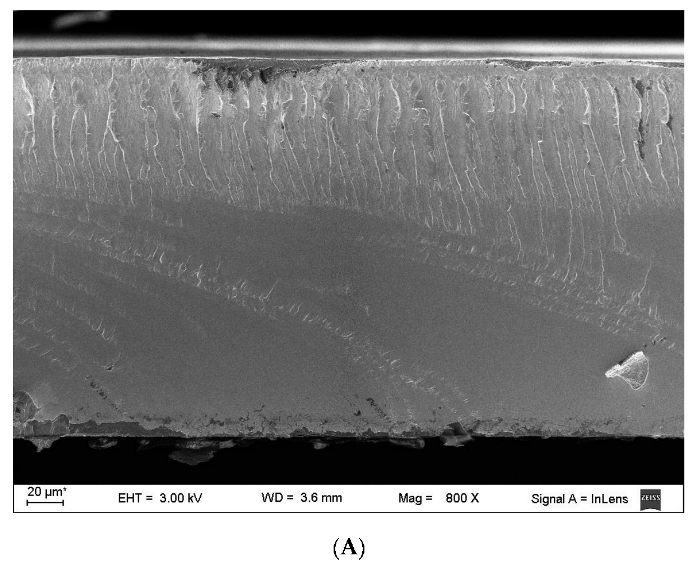
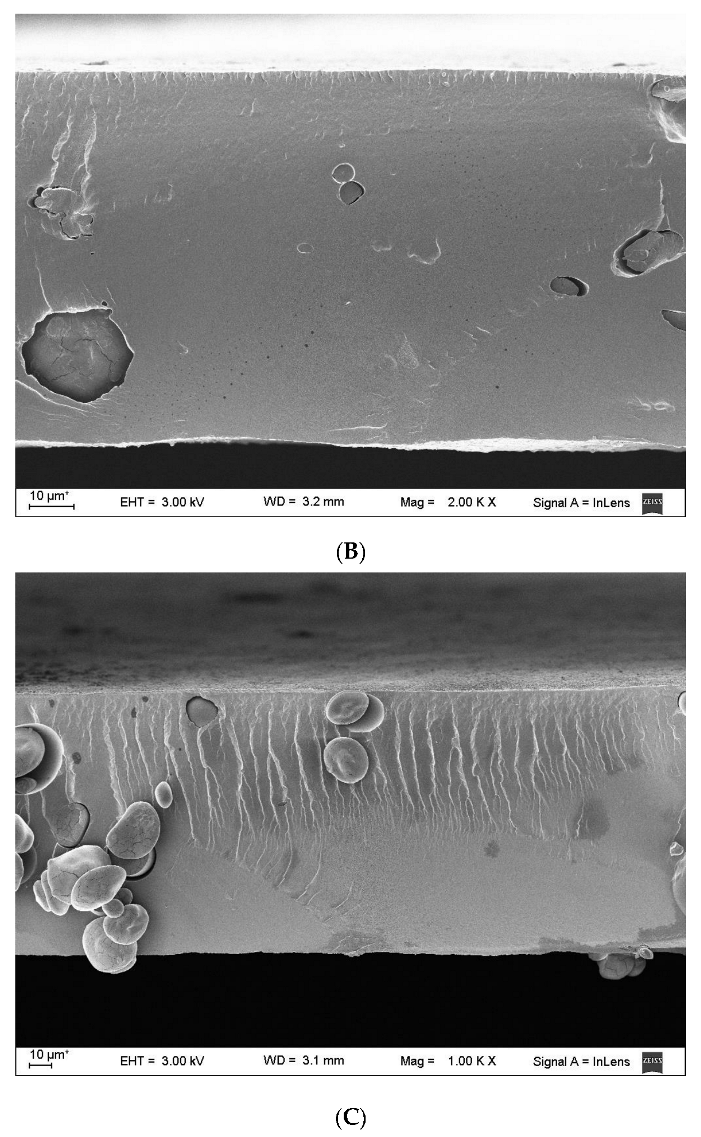
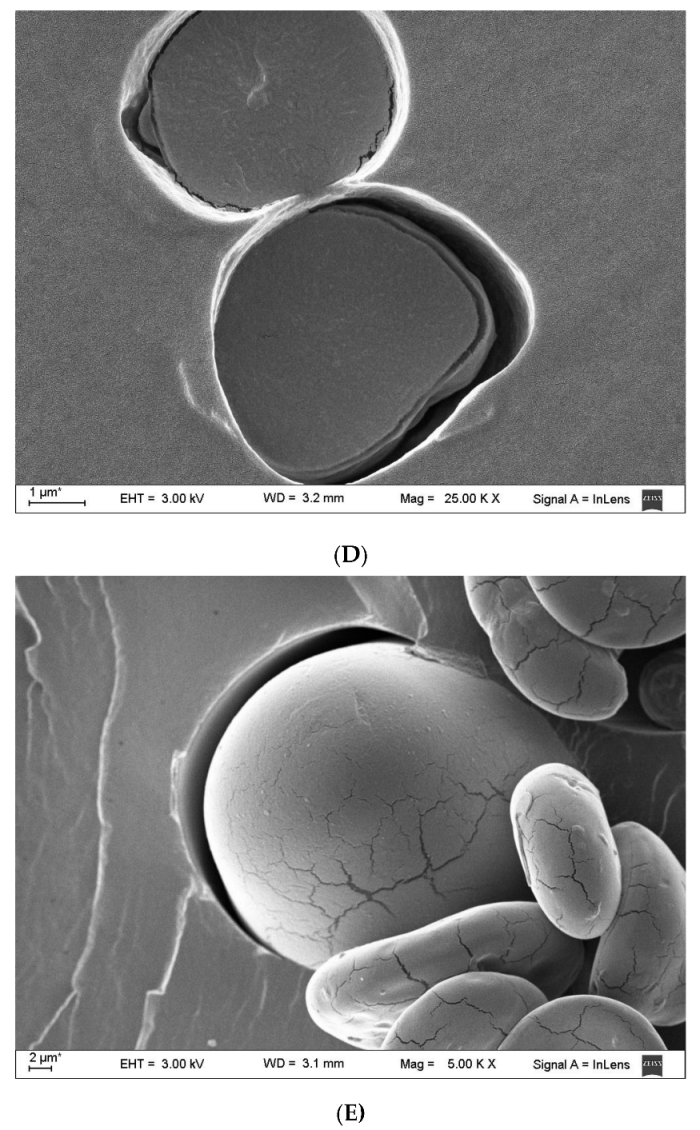
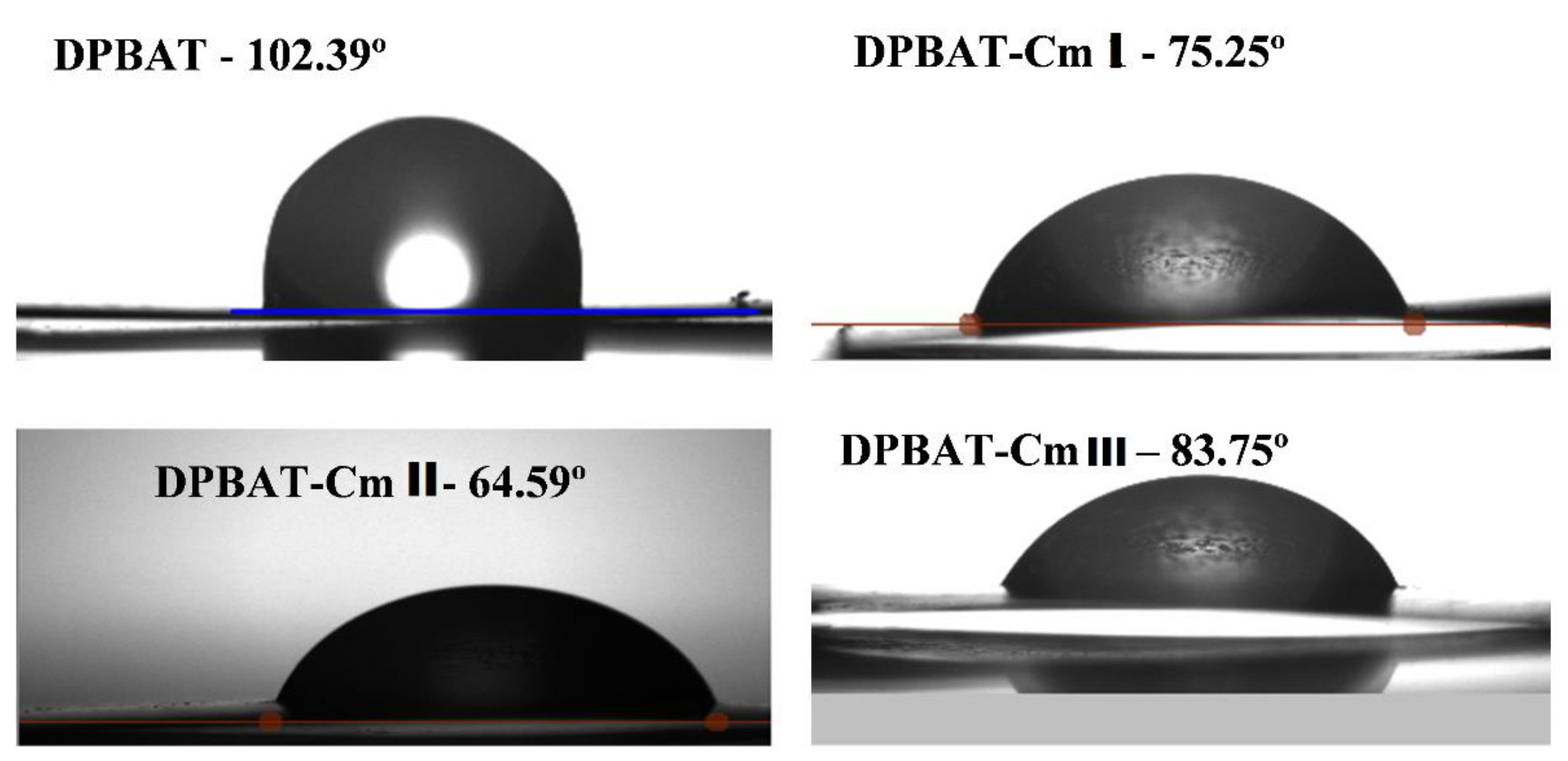

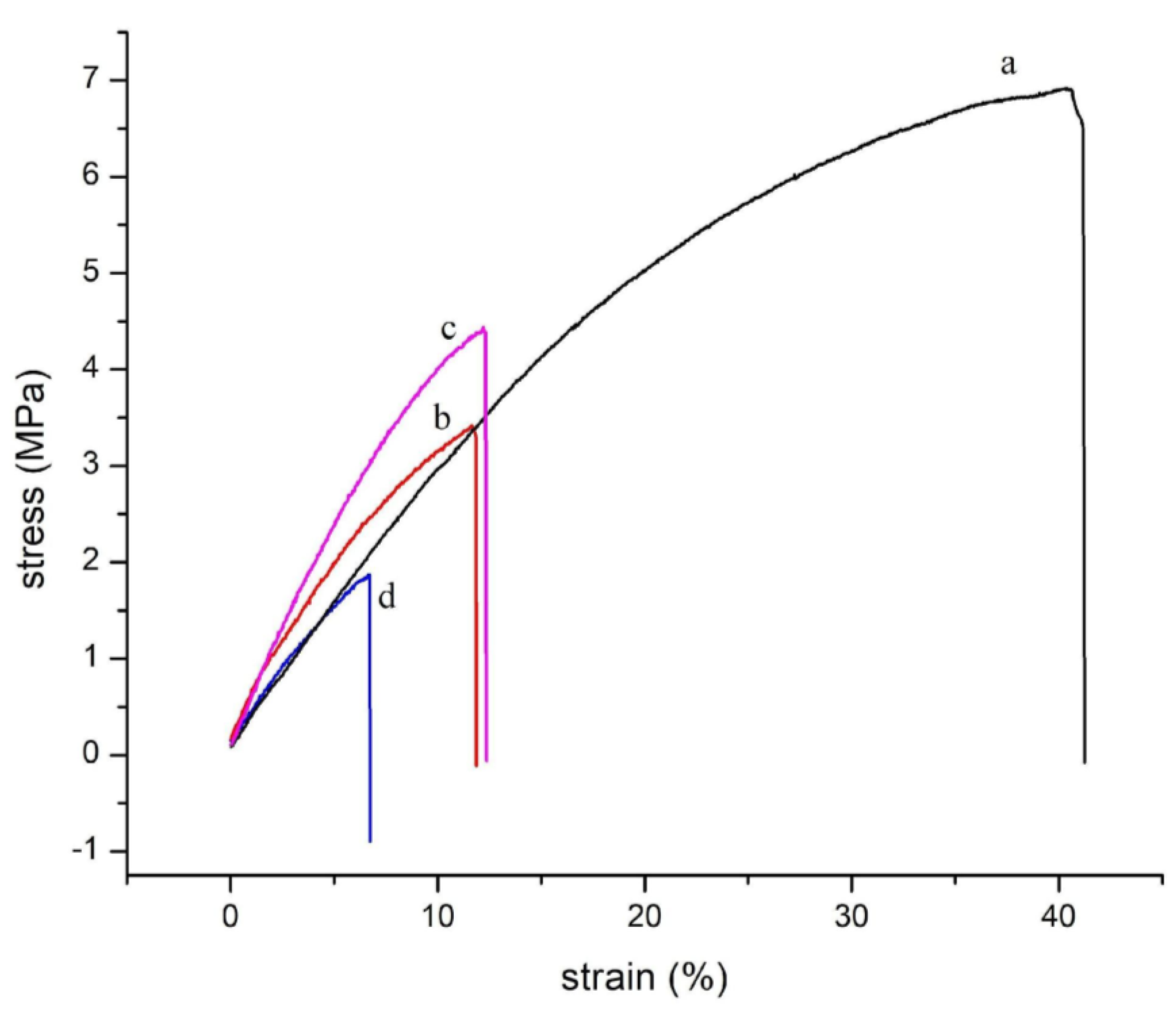

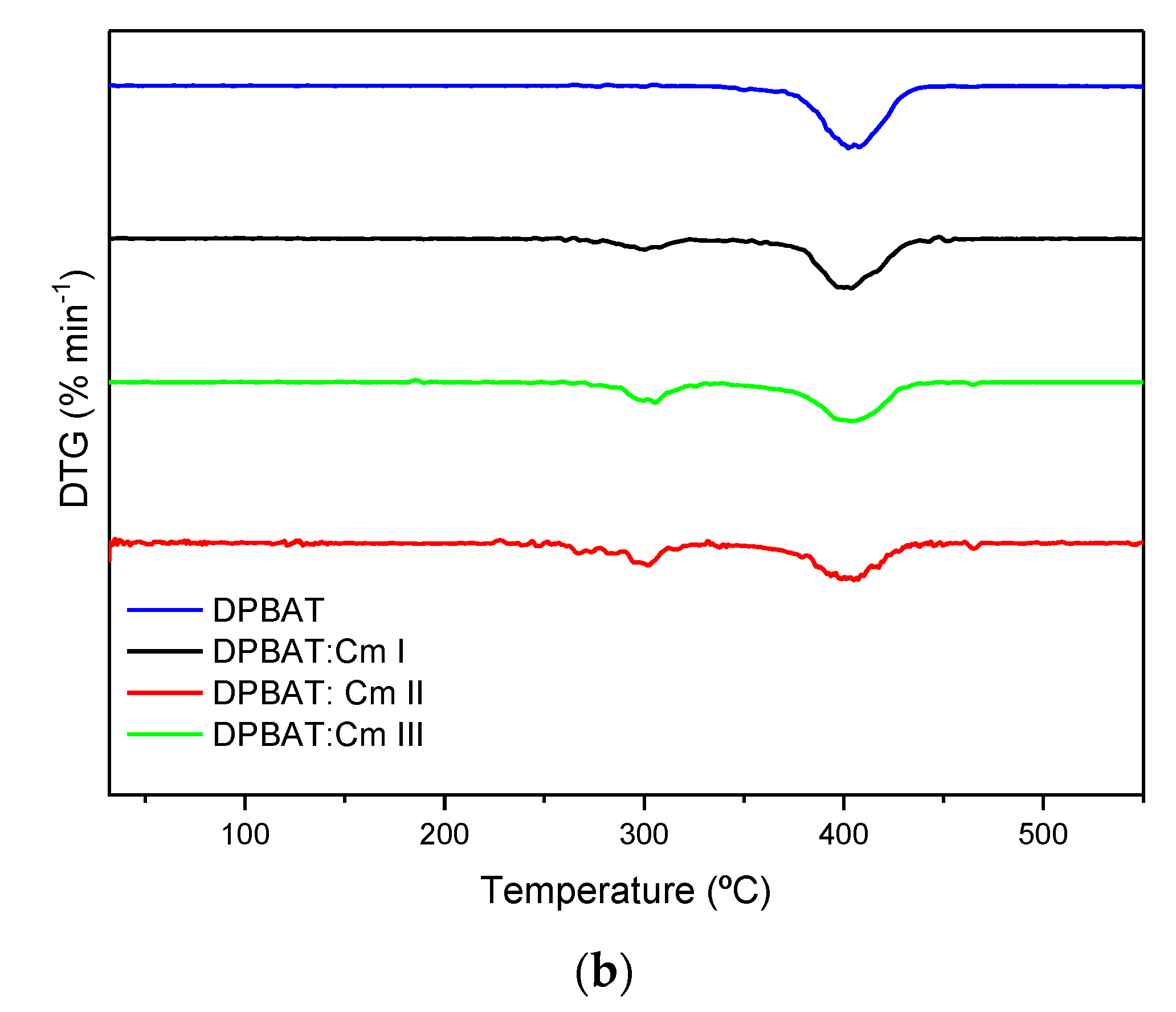
| Formulations | Cm (g) | Glycerol (g) | DPBAT (g) |
|---|---|---|---|
| DPBAT | - | - | 100 |
| DPBAT:Cm I | 22.5 | 7.5 | 70 |
| DPBAT:Cm II | 30.0 | 10.0 | 60 |
| DPBAT:Cm III | 37.5 | 12.5 | 50 |
| Formulations | Moisture (%) | Contact Angle (°) | Thickness (μm) | Tensile Strength (MPa) | Elongation at Break (%) | Young’s Modulus (MPa) |
|---|---|---|---|---|---|---|
| DPBAT | 0.5 ± 0.01 a | 102.39 | 185 ± 45 b | 5.47 ± 1.31 c | 31.94 ± 9.21 a | 32.83 ± 3.94 a |
| DPBAT:Cm I | 4.0 ± 0.04 c | 75.25 | 143 ± 29 a,b | 1.86 ± 0.81 b | 7.07 ± 3.43 b | 30.85 ± 4.72 b |
| DPBAT:Cm II | 2.5 ± 0.05 b | 64.59 | 133 ± 15 a | 0.98 ± 0.43 a | 2.38 ± 0.95 a | 39.95 ± 8.83 a |
| DPBAT:Cm III | 5.5 ± 0.05 d | 83.75 | 144 ± 23 a,b | 3.16 ± 0.38 a,b | 9.31 ± 1.05 a | 53.28 ± 10.38 a |
| Films | Moisture (%) | Tonset (°C) | Mass Loss (%) | Residue (%) | ||
|---|---|---|---|---|---|---|
| 1st | 2nd | 1st | 2nd | |||
| DPBAT | 0.40 | - | 332.0 | - | 96.42 | 3.20 |
| DPBAT:Cm I | 1.89 | 267.3 | 347.6 | 16.92 | 77.73 | 3.46 |
| DPBAT:Cm II | 2.48 | 255.9 | 353.4 | 62.46 | 62.46 | 1.73 |
| DPBAT:Cm III | 2.49 | 262.1 | 340.4 | 24.73 | 68.65 | 4.13 |
Disclaimer/Publisher’s Note: The statements, opinions and data contained in all publications are solely those of the individual author(s) and contributor(s) and not of MDPI and/or the editor(s). MDPI and/or the editor(s) disclaim responsibility for any injury to people or property resulting from any ideas, methods, instructions or products referred to in the content. |
© 2023 by the authors. Licensee MDPI, Basel, Switzerland. This article is an open access article distributed under the terms and conditions of the Creative Commons Attribution (CC BY) license (https://creativecommons.org/licenses/by/4.0/).
Share and Cite
Grimaut, D.A.; da Silva, J.B.A.; Lemos, P.V.F.; Correia, P.R.C.; Santana, J.S.; Pessôa, L.C.; Estevez-Areco, S.; Famá, L.M.; Goyanes, S.N.; Marcelino, H.R.; et al. Effect of Addition of Cross-Linked Starch on the Properties of Degraded PBAT Poly(butylene adipate-co-terephthalate) Films. Polymers 2023, 15, 3106. https://doi.org/10.3390/polym15143106
Grimaut DA, da Silva JBA, Lemos PVF, Correia PRC, Santana JS, Pessôa LC, Estevez-Areco S, Famá LM, Goyanes SN, Marcelino HR, et al. Effect of Addition of Cross-Linked Starch on the Properties of Degraded PBAT Poly(butylene adipate-co-terephthalate) Films. Polymers. 2023; 15(14):3106. https://doi.org/10.3390/polym15143106
Chicago/Turabian StyleGrimaut, Denise Agostina, Jania Betania Alves da Silva, Paulo Vitor França Lemos, Paulo Romano Cruz Correia, Jamille Santos Santana, Luiggi Cavalcanti Pessôa, Santiago Estevez-Areco, Lucía Mercedes Famá, Silvia Nair Goyanes, Henrique Rodrigues Marcelino, and et al. 2023. "Effect of Addition of Cross-Linked Starch on the Properties of Degraded PBAT Poly(butylene adipate-co-terephthalate) Films" Polymers 15, no. 14: 3106. https://doi.org/10.3390/polym15143106
APA StyleGrimaut, D. A., da Silva, J. B. A., Lemos, P. V. F., Correia, P. R. C., Santana, J. S., Pessôa, L. C., Estevez-Areco, S., Famá, L. M., Goyanes, S. N., Marcelino, H. R., de Jesus Assis, D., & de Souza, C. O. (2023). Effect of Addition of Cross-Linked Starch on the Properties of Degraded PBAT Poly(butylene adipate-co-terephthalate) Films. Polymers, 15(14), 3106. https://doi.org/10.3390/polym15143106







